英文摘要撰写的技巧.
写好英文论文摘要的七个要素

写好英文论文摘要的七个要素英文论文摘要是英文论文最开始的部分,其重要性可想而知。
它就像是一篇论文的眼睛,如何用一双顾盼神飞的眼睛赢得评审老师的心?1. 英文摘要是什么?ABSTRACT ,是用最为浓缩的语言将你论文的核心内容表述出来。
不需要你用华丽的语言去描述!只留下普通、平实的内容。
2. 如何写英文摘要?可以按照论文的逻辑结构撰写摘要,如概述、目的、方法、结果、结论、展望的顺序。
概述(30词左右):用最简洁的语言概括论文内容。
例如:This This paper paper paper is is …或This This study study focuses on …目的(30词左右):用T o …就可以了,没有必要使用in order to 或者或者for the purpose of 等较长的表述。
方法(50词左右):尽可能具体地说明操作的步骤,其中注意时态的使用。
常用的词汇有:test, study, inves gate, examine, analyze, measure, applica on 等。
结果(50词左右):直入主题地摆出结果,如This paper shows …或The results are …结论(60词左右):删去类似于“The result of the study showed that …”的赘语,逐条罗列出结论。
展望(20词左右):指出研究对未来的意义,如This paper is of great significance in …或指出不足。
3. 常用什么语态?规范的学术文章通常采用被动语态,规范的学术文章通常采用被动语态,突出信息。
突出信息。
但由于主动语态的表述更为清楚,但由于主动语态的表述更为清楚,现在现在有些地方也要求采用主动语态。
4. 常用什么人称?最好不要出现I ,we 等第一人称代词,而是使用第三人称,如the author 等。
5. 一般有多少字?一般情况下用一段的篇幅完成英文摘要,特殊情况可以分成两到三段,但最好不要超过三段。
英文摘要写作技巧

investigated the role of omeprazole and influence of primary H. pylori resistance on eradication and developmen 三、介绍目的常用句型 主要用动词不定式to表达 1.直接用to do短语表达 举例:To determine if use of omeprazole protects against the gastric mucosal injury 2.The purpose/aim/objective/goal(of present study is)was to 举例:The aim of this study was to determine the protective function of omeprazole on gastric mucosal injury3
英文摘要构式摘要 缺点:段落不明,给编辑、审稿、阅读和计算机处理带来诸多不便 2.全结构式摘要(8要素摘要) (1)目的 (2)设计 (3)地点 (4)对象 (5)处理 (6)主要测定项目 (7)结果 (8)结论 全结构式摘要的优点 (1)观点更明确 (2)信息量更大 (3)差错更少 (4)符合计算机数据库建立和使用的要求 全结构式摘要的缺点:烦琐、重复、篇幅过长 3.半结构式摘要(四要素摘要) (1)目的(objective/purpose/aim) (2)方法(methods) (3)结果(results) (4)结论(conclusion) u 目的 是主题,是作者相要介绍的关键问题 一、目的格式 (一)单表目的 (二)背景+目的 二、目的常用时态 (一)背景:现在时(一般现在时、完成时和进行时) (二)目的:一般现在时/现在完成时,或一般过去时 举例: (1)To evaluate the effects on 24-hour intragastric pH levels of infusions with omeprazole and H2 receptor an
英语摘要怎么写作业
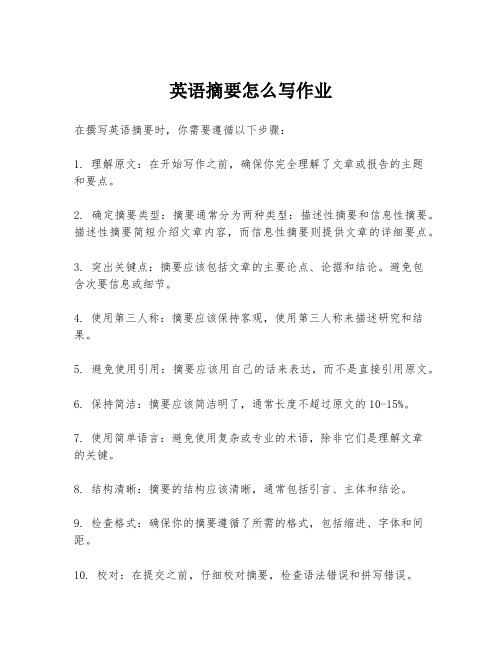
英语摘要怎么写作业在撰写英语摘要时,你需要遵循以下步骤:1. 理解原文:在开始写作之前,确保你完全理解了文章或报告的主题和要点。
2. 确定摘要类型:摘要通常分为两种类型:描述性摘要和信息性摘要。
描述性摘要简短介绍文章内容,而信息性摘要则提供文章的详细要点。
3. 突出关键点:摘要应该包括文章的主要论点、论据和结论。
避免包含次要信息或细节。
4. 使用第三人称:摘要应该保持客观,使用第三人称来描述研究和结果。
5. 避免使用引用:摘要应该用自己的话来表达,而不是直接引用原文。
6. 保持简洁:摘要应该简洁明了,通常长度不超过原文的10-15%。
7. 使用简单语言:避免使用复杂或专业的术语,除非它们是理解文章的关键。
8. 结构清晰:摘要的结构应该清晰,通常包括引言、主体和结论。
9. 检查格式:确保你的摘要遵循了所需的格式,包括缩进、字体和间距。
10. 校对:在提交之前,仔细校对摘要,检查语法错误和拼写错误。
摘要示例:> The article explores the impact of social media on adolescent mental health. It presents a comprehensive study involving 1,000 participants, highlighting a significant increase in anxiety and depression among frequent users. The study suggests that excessive screen time and social comparison contribute to these mental health issues. The author recommends implementing digital literacy programs in schools to educate adolescents on the responsible use of social media.通过遵循这些步骤,你可以有效地撰写出高质量的英语摘要。
论文摘要的英文技巧有哪些

论文摘要的英文技巧有哪些
撰写论文摘要时需要注意以下几个英文技巧:
1. 简明扼要:摘要应简洁概括论文的主要内容,避免冗长与重复。
通常,摘要应在150-250字之间。
2. 选择关键词:摘要中应精选出几个能够准确描述论文主题的关键词,以便读者能够快速了解论文的主要内容。
3. 使用正确的语法和语句结构:确保摘要中的语法和语句结构正确,避免使用过于复杂或难以理解的词汇和句式。
4. 强调创新性和重要性:在摘要中强调论文的创新性和重要性,以吸引读者的兴趣并突出研究的独特之处。
5. 按照论文结构组织:摘要应按照论文的结构组织,包括背景、目的、方法、结果和结论等要素。
这样可以确保摘要的逻辑性和连贯性。
6. 避免使用缩写和非专业术语:摘要应尽量避免使用过多的缩写和非专业术语,以确保读者能够理解论文的主要内容。
7. 语言简练、清晰明了:摘要应使用简洁、清晰和明了的语言,确保读者能够
迅速理解研究的目的、方法和结果。
8. 自我评估和编辑:在写完摘要后,对其进行自我评估和编辑,检查语法错误、流畅性和逻辑性等方面的问题,确保摘要的质量。
英文摘要的写作技巧
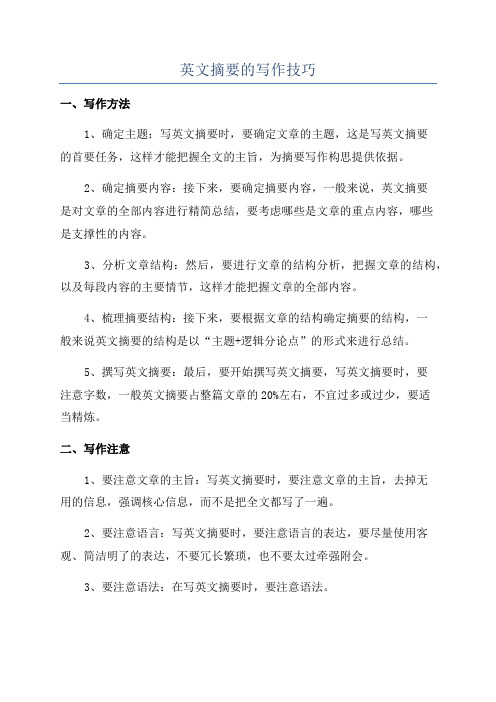
英文摘要的写作技巧
一、写作方法
1、确定主题:写英文摘要时,要确定文章的主题,这是写英文摘要
的首要任务,这样才能把握全文的主旨,为摘要写作构思提供依据。
2、确定摘要内容:接下来,要确定摘要内容,一般来说,英文摘要
是对文章的全部内容进行精简总结,要考虑哪些是文章的重点内容,哪些
是支撑性的内容。
3、分析文章结构:然后,要进行文章的结构分析,把握文章的结构,以及每段内容的主要情节,这样才能把握文章的全部内容。
4、梳理摘要结构:接下来,要根据文章的结构确定摘要的结构,一
般来说英文摘要的结构是以“主题+逻辑分论点”的形式来进行总结。
5、撰写英文摘要:最后,要开始撰写英文摘要,写英文摘要时,要
注意字数,一般英文摘要占整篇文章的20%左右,不宜过多或过少,要适
当精炼。
二、写作注意
1、要注意文章的主旨:写英文摘要时,要注意文章的主旨,去掉无
用的信息,强调核心信息,而不是把全文都写了一遍。
2、要注意语言:写英文摘要时,要注意语言的表达,要尽量使用客观、简洁明了的表达,不要冗长繁琐,也不要太过牵强附会。
3、要注意语法:在写英文摘要时,要注意语法。
摘要写作进阶指导五:如何写好英文摘要

摘要写作进阶指导五:如何写好英文摘要第一篇:摘要写作进阶指导五:如何写好英文摘要如何写好英文摘要收录学报文章的国外检索数据库刊登的条目内容有题名、作者、英文摘要、参考文献等等。
摘要的质量非常重要。
一方面检索数据库要依据摘要的质量来决定该文章是否被收录;另一方面读者要根据摘要提供的信息考虑是否阅读、引用原文,如能被利用,才能体现文章的学术价值,提高原文的引用频次。
因此希望广大作者按规范认真编写英文摘要。
具体要求如下:1.英文摘要应与中文摘要相对应;2.语言简洁。
避免使用一长串形容词或名词来修饰名词。
不加评论语句,如“相当满意”、“令人可喜”等。
不使用多余的词语,如“据报道……”、“大量的调查表明……”等。
尽量减少背景信息,如历史或其它注释。
不要写作者将来的打算。
应尽量删去的主要字句有:in this paper、based on the analyses conducted、on the above basis、in detail、briefly、mainly、in addition、qualitatively、furthermore等等;3.信息量要完整,能够全面包含论文的关键信息,主要内容有:目的(主题)、研究方法(途经)、研究结果和结论;4.首句不得简单重复题名中已有的信息,要采用简洁的被动语态或原形动词开头,如:A mathematical model for digital closed-loop fiber-optics gyroscopes was established to get the difference equation of the model.T o study…,To describe…,T o investigate…,To assess…,To determine…5.描述目的、结论等用一般现在时,说明研究的方法、过程等用一般过去时。
较少采用现在完成时态、过去完成时态、进行时态等;6.长度一般不能超过150个英文单词,但也不能太短;7.一般情况下不能用缩写,尤其是不常用的专业词语,应使用全称,且均用小写;8.不要有数学公式、矩阵、数列、希腊字母,不要出现角标的角标等不规范字符。
英文摘要的写作方法与技巧

英文摘要的写作方法与技巧论文摘要是全文的精华,是对一项科学研究工作的总结,对研究目的、方法和研究结果的概括。
笔者根据自己摘要写作的经验并结合专业英语教学和对学生英文摘要的批改,谈谈写好英文摘要的方法和技巧。
英文摘要的写作包括论文的英文标题、作者及其相关信息、摘要和关键词四个部分,下面分别介绍每个部分的写作方法与技巧。
1 论文标题论文标题是全文内容的缩影。
读者通过标题便能够预测论文的主要内容和作者的意图,从而决定是否阅读全文。
我国期刊要求论文题目一般不超过20个汉字,外文题名一般不超过10个实词[1]。
学术文章的标题主要有三种结构:名词性词组(包括动名词)、介词词组、名词词组+介词词组。
间或也用一个疑问句做标题,但一般不用陈述句或动词词组做标题。
(1)名词性词组名词性词组由名词及其修饰语构成。
名词的修饰语可以是形容词、介词短语,又是也可以是另一个名词。
以下各标题分别由两个名词词组构成。
例如:Global Change and Green House Effect(名词词组+名词词组);Adaptation and Mitigation to the Global Change(名词+名词)。
(2)介词词组介词词组由介词+名词或名词词组构成。
如果整个标题就是一个介词词组的话,一般这个介词是on,意思是对的研究。
例如:On the Ecological Obligation。
(3)名词/名词词组+介词词组这是标题中用得最多的结构。
例如:Global Environment Change and Its Impact on Plants(名词词组+名词词组);Discussion on System Method of Studying Global Environmental Change(名词+介词词组)。
(4)其他形式对于值得争议的问题,偶尔可用疑问句作为论文的标题,以点明整个论文讨论的焦点。
例如:Can Global Change Bring Dramatic Disasters to Humans?2 作者学术论文既可以个人名义署名,也可以集体名义署名。
英语摘要十大万能模板
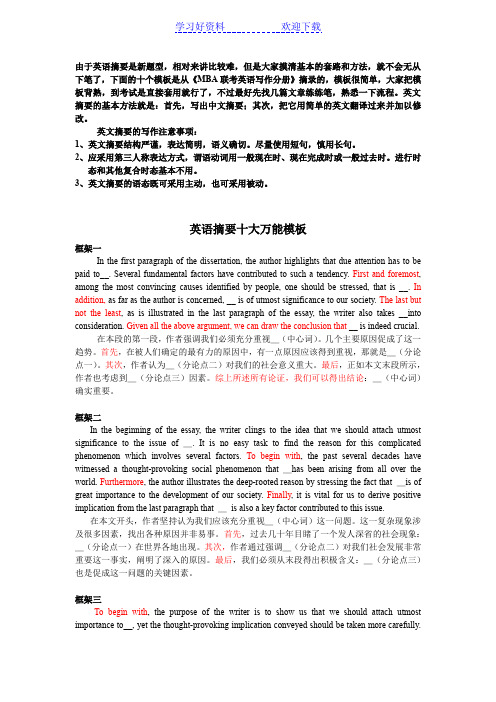
由于英语摘要是新题型,相对来讲比较难,但是大家摸清基本的套路和方法,就不会无从下笔了,下面的十个模板是从《MBA联考英语写作分册》摘录的,模板很简单,大家把模板背熟,到考试是直接套用就行了,不过最好先找几篇文章练练笔,熟悉一下流程。
英文摘要的基本方法就是:首先,写出中文摘要;其次,把它用简单的英文翻译过来并加以修改。
英文摘要的写作注意事项:1、英文摘要结构严谨,表达简明,语义确切。
尽量使用短句,慎用长句。
2、应采用第三人称表达方式,谓语动词用一般现在时、现在完成时或一般过去时。
进行时态和其他复合时态基本不用。
3、英文摘要的语态既可采用主动,也可采用被动。
英语摘要十大万能模板框架一In the first paragraph of the dissertation, the author highlights that due attention has to be paid to__. Several fundamental factors have contributed to such a tendency. First and foremost, among the most convincing causes identified by people, one should be stressed, that is __. In addition, as far as the author is concerned, __ is of utmost significance to our society. The last but not the least, as is illustrated in the last paragraph of the essay, the writer also takes __into consideration. Given all the above argument, we can draw the conclusion that __ is indeed crucial.在本段的第一段,作者强调我们必须充分重视_(中心词)。
如何写英语论文摘要

如何写英语论文摘要
在撰写一个英语论文的摘要时,有几个关键要点需要考虑,以确保摘要的质量和信息量。
以下是撰写英语论文摘要的六个步骤。
1.确定摘要的类型:
-描述性摘要:简要概述论文的主要内容和结论。
-说明性摘要:除了提供主要内容和结论外,还解释研究的意义和方法。
-评论性摘要:除了提供主要内容和结论外,还对论文进行评估和批判。
2.单独撰写摘要:
摘要应该是一个独立的部分,不应与论文的其他部分混淆。
即使读者只阅读摘要,也应该能够理解论文的主要内容和结论。
3.按照一定的结构撰写:
摘要应该包括以下几个部分:
-引言:介绍研究的背景和目的。
-方法:简要描述研究所用的方法和研究对象。
-结果:总结研究的主要结果。
-讨论:讨论研究结果的意义和可能的局限性。
-结论:阐述研究的主要结论。
4.保持简洁:
摘要应该尽量精炼、简明扼要地表达论文的主要内容。
避免冗长的插入语和过多的细节。
5.不要引用:
6.仔细校对:
在撰写完摘要后,仔细校对并检查语法、拼写和语句结构。
确保摘要的清晰、准确和流畅。
总之,在撰写英语论文摘要时,应该多花时间思考和规划摘要的结构和内容。
通过提供简明的综述和清晰的结论,摘要应该能够吸引读者并引起他们对论文的兴趣。
英语作文摘要
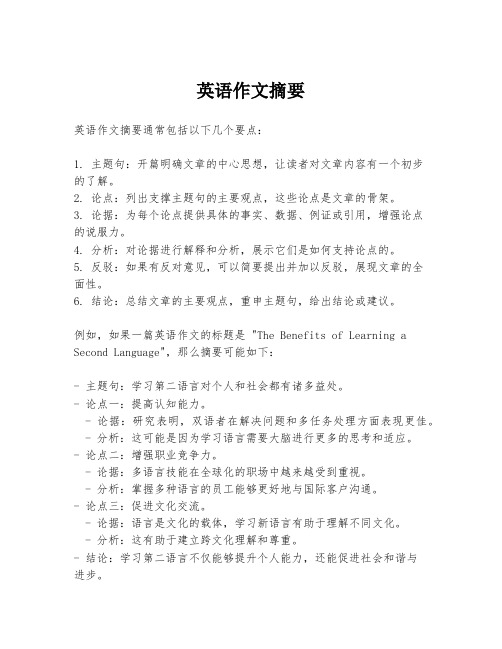
英语作文摘要
英语作文摘要通常包括以下几个要点:
1. 主题句:开篇明确文章的中心思想,让读者对文章内容有一个初步
的了解。
2. 论点:列出支撑主题句的主要观点,这些论点是文章的骨架。
3. 论据:为每个论点提供具体的事实、数据、例证或引用,增强论点
的说服力。
4. 分析:对论据进行解释和分析,展示它们是如何支持论点的。
5. 反驳:如果有反对意见,可以简要提出并加以反驳,展现文章的全
面性。
6. 结论:总结文章的主要观点,重申主题句,给出结论或建议。
例如,如果一篇英语作文的标题是 "The Benefits of Learning a Second Language",那么摘要可能如下:
- 主题句:学习第二语言对个人和社会都有诸多益处。
- 论点一:提高认知能力。
- 论据:研究表明,双语者在解决问题和多任务处理方面表现更佳。
- 分析:这可能是因为学习语言需要大脑进行更多的思考和适应。
- 论点二:增强职业竞争力。
- 论据:多语言技能在全球化的职场中越来越受到重视。
- 分析:掌握多种语言的员工能够更好地与国际客户沟通。
- 论点三:促进文化交流。
- 论据:语言是文化的载体,学习新语言有助于理解不同文化。
- 分析:这有助于建立跨文化理解和尊重。
- 结论:学习第二语言不仅能够提升个人能力,还能促进社会和谐与
进步。
摘要应当简洁明了,避免冗长和不必要的细节,使读者能够快速把握文章的核心内容。
英文摘要写作技巧四种固定句型
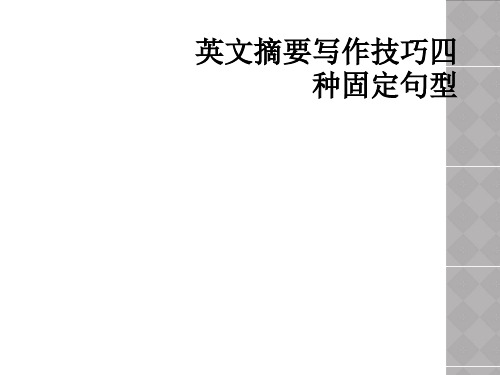
4、检测句
在A样本中对B参数的检测,可套用: “Detection of B parameter in A sample”。 例如,在抽动障碍儿童中对A蔟溶血性链球菌抗 体的测定,可译作: “Detection of group A streptococcal antibody in childre n with tic disorders”。
3、相关句
在C组中A参数与B参数之间有显著正相关、负相关或无 相关,可套用:“There was a significantly positive or negative correlation between parameter A and parameter B in group C”。
例如,在38例精神分裂症病人中脑脊液多巴胺水平与5 羟色胺水平之间有显著正相关,译作There was a significantly positive correlation between CSF Dopamine level and CSF 5-hydroxytryptamine level in 38 patients with schizophrenia”。
分析: ① 词语搭配不当:effect 应与on 连用; ② 选词不当:轻病区用mild 一词。
修改为: Effects of different iodine content in salt on the children in severe and mild iodine deficiency areas in Guizhou , China
二、英文摘要
1、目的(Objective)
在目的中,因为是反映将要做什么,故用不定式。格式为 “探索(调查或研究)+文题”
英文摘要的写作要求

英文摘要的写作要求在学术研究中,英文摘要是非常重要的一部分。
虽然摘要通常只有几百字,但它能够为读者提供研究的核心内容和结论。
因此,撰写规范、简明扼要的英文摘要是非常重要的。
这里介绍几点英文摘要的写作要求。
1. 简明扼要摘要应该简明扼要地概括文章的要点,避免冗长和复杂的句子结构。
最好将摘要限制在250个词左右,这样可以保证足够的信息量同时又不会太长。
2. 独立自主摘要应该是一篇独立自主的文本,可以单独阅读而不需要参考正文。
因此,在撰写摘要时,应该避免将太多的细节和背景信息纳入其中,而是应该集中阐述文章所研究的问题、研究方法和结果、结论和重要的贡献。
3. 结构清晰摘要应该遵循逻辑和清晰的结构,包括简要的介绍背景和目的,阐述研究的方法、结果和结论、以及强调研究的贡献和意义。
尽管这些内容不能太长,但它们应该都得到适当的覆盖。
4. 包含关键词在摘要中引入文中的关键词和短语可以为读者提供快速理解文章主题的方法。
同时,适当使用关键词也有助于提高文章在搜索和索引中的可见性。
因此,在撰写摘要时,应该特别注意选择准确的关键词。
5. 避免翻译错误如果英文不是母语,可能会出现翻译错误。
这种错误往往会影响文章的可读性和可信度。
因此,在撰写摘要时,应该特别注意拼写和语法,以确保摘要的语言流畅、准确和易于理解。
6. 重点突出最后,摘要应该突出文章的重点和贡献。
这将使读者更容易理解文章的意义,并以此来判断文章是否值得花费时间进行深入研究。
总之,英文摘要是学术研究中不可或缺的一部分,并在论文发表、报告、申请和提供基金等方面扮演着重要角色。
因此,撰写简洁明了、语言通顺和准确的英文摘要是一个非常重要的技能,值得我们认真学习和提高。
英文摘要的书写技巧

英文摘要的书写技巧英文摘要通常是学术论文、科技报告、研究成果等的第一篇引言,短小精悍地概括了文章的主要内容和意义。
因此,良好的英文摘要是保证文章成功的基础之一。
下面我们来谈一谈英文摘要的书写技巧。
一、准确翻译思路英文摘要通常是中文原文的直接翻译,因此必须先确保中文原文表达的思路、结构、内容的翻译准确无误。
翻译在整个英文摘要中扮演着至关重要的角色。
精准的翻译可以使读者更好地理解文章,突显作者的研究价值。
二、简明扼要地表达研究目的和主题在英文摘要中,作者必须简明扼要地表达文章的主题和研究目的。
语言应当简练,措辞准确明确,尽量避免使用模糊、罗嗦的词汇。
在表述研究目的的同时,需要说明该研究为何具有重要性和应用前景,这有助于提高读者的兴趣和关注度。
三、突出研究方法和成果英文摘要应当突出研究方法和成果,作者应当简明扼要地说明采用的研究方法和技术,以及所得到的主要研究成果。
在突出研究方法的同时,必须确保语言简练,避免使用过多的专业术语和公式,增强阅读体验。
四、突出文章的创新点和贡献英文摘要中应当突出文章的创新点和贡献。
作者应当清晰阐述论文的独特性、创新性,突出自己的贡献和价值。
这些创新点和贡献是吸引读者和其他研究者对文章进行深入研究的重要因素。
五、注意英文语法和表达方式英文摘要是文章的门面,因此要注意英文语法和表达方式。
在撰写英文摘要的时候,应当尽量使用简单明了的语言,突出文章主旨,并注意英文语法中的时态、语态和词性等问题。
特别是在使用专业术语的时候,要确保使用正确,并注意缩写表述的准确性和标点符号的正确使用。
六、注意逻辑和流畅度英文摘要在语言、结构和内容方面都需要严密把握,从而使整篇文章的逻辑性更加强大准确,流畅度更加突出。
要注意写作结构的组合,通过适当的段落进行分隔和连接,让阅读者更好地理解文章脉络。
此外,要注重内容的全面性和准确性,从而使研究更具说服力和参考性。
综上所述,英文摘要的书写技巧涉及到语言的准确性、表达方式的简洁清晰性、逻辑性和流畅度。
Summary的写作技巧和常见句型
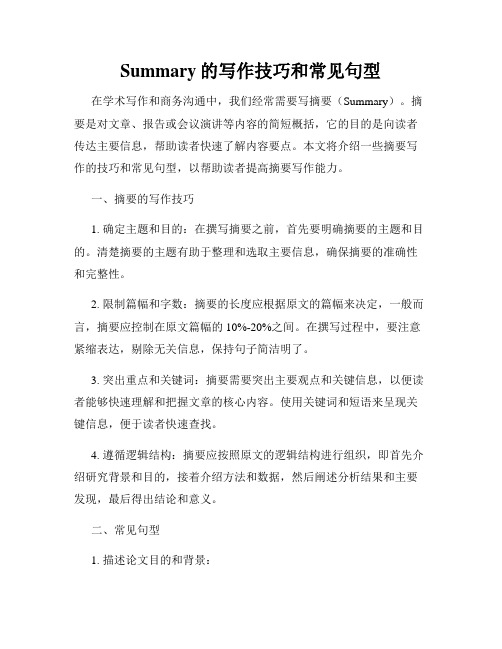
Summary的写作技巧和常见句型在学术写作和商务沟通中,我们经常需要写摘要(Summary)。
摘要是对文章、报告或会议演讲等内容的简短概括,它的目的是向读者传达主要信息,帮助读者快速了解内容要点。
本文将介绍一些摘要写作的技巧和常见句型,以帮助读者提高摘要写作能力。
一、摘要的写作技巧1. 确定主题和目的:在撰写摘要之前,首先要明确摘要的主题和目的。
清楚摘要的主题有助于整理和选取主要信息,确保摘要的准确性和完整性。
2. 限制篇幅和字数:摘要的长度应根据原文的篇幅来决定,一般而言,摘要应控制在原文篇幅的10%-20%之间。
在撰写过程中,要注意紧缩表达,剔除无关信息,保持句子简洁明了。
3. 突出重点和关键词:摘要需要突出主要观点和关键信息,以便读者能够快速理解和把握文章的核心内容。
使用关键词和短语来呈现关键信息,便于读者快速查找。
4. 遵循逻辑结构:摘要应按照原文的逻辑结构进行组织,即首先介绍研究背景和目的,接着介绍方法和数据,然后阐述分析结果和主要发现,最后得出结论和意义。
二、常见句型1. 描述论文目的和背景:本文旨在研究/探讨/分析...(The aim of this study is toresearch/explore/analyze...)在过去的几十年里,...(In the past decades, ...)2. 介绍研究方法和数据:通过对...进行调查/实验/分析...(By conducting asurvey/experiment/analysis on...)本研究采用问卷调查/实地观察/统计数据...(This study employs a questionnaire survey/field observation/statistical data...)3. 阐述分析结果和主要发现:研究结果表明...(The results of this study indicate that...)实验结果显示...(The experimental findings demonstrate that...)4. 提出结论和意义:综上所述,本研究...对...具有重要意义(In conclusion, this study has significant implications for...)这些发现对于...具有重要启示(These findings provide important insights into...)总之,撰写摘要需要注意确定主题和目的,限制篇幅和字数,突出重点和关键词,并遵循逻辑结构。
英文摘要的写作技巧

英文摘要的写作技巧英文摘要的写作技巧导语:英文摘要(Abstract)的写作应用很广。
论文摘要是全文的精华,是对一项科学研究工作的总结,对研究目的、方法和研究结果的概括。
以下是小编为大家精心整理的英文摘要的写作技巧,欢迎大家阅读参考!一、摘要的种类与特点摘要主要有以下四种。
第一种是随同论文一起在学术刊物上发表的摘要。
这种摘要置于主体部分之前,目的是让读者首先了解一下论文的内容,以便决定是否阅读全文。
一般来说,这种摘要在全文完成之后写。
字数限制在100~150字之间。
内容包括研究目的、研究方法、研究结果和主要结论。
第二种是学术会议论文摘要。
会议论文摘要往往在会议召开之前几个月撰写,目的是交给会议论文评审委员会评阅,从而决定是否能够录用。
所以,比第一种略为详细,长度在200—300字之间。
会议论文摘要的开头有必要简单介绍一下研究课题的意义、目的、宗旨等。
如果在写摘要时,研究工作尚未完成,全部研究结果还未得到,那么,应在方法、目的、宗旨、假设等方面多花笔墨。
第三种为学位论文摘要。
学士、硕士和博士论文摘要一般都要求用中、英文两种语言写。
学位论文摘要一般在400字左右,根据需要可以分为几个段落。
内容一般包括研究背景、意义、主旨和目的;基本理论依据,基本假设;研究方法;研究结果;主要创新点;简短讨论。
不同级别的学位论文摘要,要突出不同程度的创新之处,指出有何新的观点、见解或解决问题的新方法。
第四种是脱离原文而独立发表的摘要。
这种摘要更应该具有独立性、自含性、完整性。
读者无需阅读全文,便可以了解全文的主要内容。
二、摘要的内容与结构摘要内容一般包括:Ø 目的(objectives,purposes):包括研究背景、范围、内容、要解决的问题及解决这一问题的重要性和意义。
Ø 方法(methods and materials):包括材料、手段和过程。
Ø 结果与简短讨论(results and discussions):包括数据与分析。
英文结构式摘要的写作技巧_论文格式_

英文结构式摘要的写作技巧医学科技论文英文结构式摘要的写作需要做到简练,准确,逻辑性强,使人读后能一目了然。
2.1 标题:是全文内容的高度概括,大多采用名词化结构(nominalization),应准确无误地表达论文的中心内容,恰如其分地反映研究范围和深度,避免过于抽象,标题中有关时间和数量等概念的表达应做到能用数字精确表达的最好不用模糊含义的词。
题目不是一个完整的句子时可省略冠词(a,an,the),是一个完整句子时,尽量保留冠词。
一般不超过10 个实词。
2.2 时态:表述文章的写作目的时用一般现在时,多用句型为:动词不定式+表述作用、关系、效果、价值等名词,如,to study; to evaluate;to explore”。
方法和结果多用过去时,结论多用一般现在时。
2.3 语态:一般以第三人称的被动语态为多,这是因为医学研究着重于客观事物和过程的描述,使得整项活动更显出科学性。
同时,被动语态的句子在结构上有较大的调节余地,有利于采用必要的修辞手段,扩大句子的信息量,从而突出重要的概念、问题、事实、结论等内容[9]。
2.4 用词:尽可能地频繁使用缩写词、名词作定语,简化句型,增大信息密度,使行文简练、结构紧凑。
医学英语的特点是派生词多、正式词汇多、名词化结构多、长句多、被动句多、非谓语动词多、专业性强等。
一定要用相应的专用词,不能望文生义,不能凭《汉英》作字面翻译,应该参考国际通用译名和医学英语专用字典的译法。
如:骨性关节炎,不能译“inflammation of bone andjoint”,应译“osteoarthritis”。
短词代替长词,常用词代替生僻词,书面语代替口语。
定语中尽可能用非谓语动词形式、缩写词和名词,不用或少用从句。
2.5 关键词:最好3个以上、6个以下关键词,建议使用mesh表中的标准词汇。
总之,一篇能确切表达医学科技论文主旨的英文结构式摘要需在人称、时态、术语、数字及单位等具体环节达到和谐统一。
英文摘要书写技巧

英文摘要书写技巧Abstract Writing Tips (1500 words)Writing an abstract is a crucial skill for researchers and academics as it helps them communicate the essence of their work in a concise and accessible manner. An abstract is a summary of a research paper, report, or article that provides an overview of the main points and findings. This article provides some useful tips for writing effective and compelling abstracts.1. Understand the Purpose of an Abstract: Before starting to write the abstract, it is important to understand its purpose. An abstract serves as a snapshot of the entire work and allows readers to quickly determine if the study is relevant to their interests. It should provide enough information to help readers decide whether to read the full paper or not.2. Follow the Structure: Abstracts generally follow a specific structure that includes the background, objective, methods, results, and conclusions of the study. However, this structure may vary depending on the requirements of the journal or conference you are submitting to. It is essential to follow the prescribed structure to ensure that all the necessary information is included.3. Be Concise: Abstracts should be concise and to the point. Since they have word limits, it is important to prioritize the most essential information and avoid unnecessary details. A good abstract should be between 150-250 words, depending on the guidelines provided by the target journal or conference.4. Use Clear and Straightforward Language: Abstracts should be written using clear and straightforward language. Avoid unnecessary jargon or technical terms that may confuse the readers. Instead, use terminology that is easily understandable to a broad audience. Remember that the purpose of an abstract is to present your work to a wider audience, including non-specialists.5. Highlight Key Points: Since abstracts serve as a summary, it is important to highlight the key points of your work. These are usually the main objectives, methods, major findings, and significant conclusions. By emphasizing these key elements, readers can get a clear idea of your research without going through the entire paper.6. Be Accurate and Objective: When writing an abstract, it is crucial to be accurate and objective. Avoid making exaggerated claims or overgeneralizations about your findings. Stick to the facts and provide a fair representation of your research. This will help establish credibility and trust among the readers.7. Avoid Citations and References: Abstracts should not include citations or references to other papers or sources. It is not the place to provide a detailed literature review. Instead, focus on summarizing your own work without external references.8. Proofread and Edit: Like any other piece of writing, abstracts should be proofread and edited to ensure clarity and correctness. Pay attention to grammar, spelling, and punctuation errors. Ensure that the abstract reads smoothly and provides a coherent summary of your study.9. Revise for Different Platforms: If you plan to submit your work to multiple journals or conferences, it is important to revise your abstract accordingly. Each target platform may have different requirements, such as word limits or specific sections to include. Tailor your abstract to meet these requirements, ensuring that it optimally represents your research for each platform.10. Seek feedback: Lastly, it is always beneficial to seek feedback from colleagues, mentors, or writing professionals. They can provide valuable insights and suggestions for improving your abstract. Incorporate their feedback to enhance the quality and impact of your abstract.In conclusion, writing an abstract requires careful consideration and attention to detail. By following these tips, you can effectively summarize your research and engage readers, ultimately increasing the visibility and impact of your work.11. Customize for Different Disciplines: It is important to keep in mind that abstracts may vary across different disciplines. Depending on the field of study, different aspects may be prioritized. For example, in scientific research, the methods and results sections may be more emphasized, while in humanities research, the theoretical framework and analysis may be more prominent. Therefore, it is crucial to tailor your abstract to the specific requirements and conventions of your discipline.12. State the Problem or Research Question: Start your abstract by clearly stating the problem or research question your study addresses. This helps readers understand the purpose and relevanceof your work. Be brief but specific in describing the issue you are investigating.13. Provide Context: In addition to stating the problem, it is important to provide some context for your study. This can include a brief background or literature review to explain the significance of the research. However, be cautious not to make the abstract too lengthy or to include excessive details. Focus on the key aspects that are directly relevant to your study.14. Summarize the Methodology: Briefly describe the methodology or approach used in your study. This includes the research design, data collection methods, and any analytical techniques employed. Highlight the key steps or procedures that are crucial for understanding your findings.15. Summarize the Results: Outline the main findings or results of your study. Be concise and specific, avoiding ambiguous or vague statements. If possible, use quantitative or qualitative data to support your conclusions. It is important to convey the most significant findings in a clear and understandable manner.16. Emphasize Novelty or Contribution: If your study has a unique or innovative aspect, make sure to highlight it in the abstract. This could be a novel methodology, a new theoretical framework, or a significant contribution to the existing literature. By emphasizing the novelty of your work, you can attract the attention of readers and make your abstract stand out.17. State the Implications and Conclusions: Conclude your abstractby summarizing the implications and conclusions of your study. Explain how your findings contribute to the existing knowledge, theory, or practice in your field. If applicable, mention any limitations or caveats of your study. By providing a clear and realistic assessment of your work, you can demonstrate its importance and practical implications.18. Include Keywords: Many journals and conferences require authors to include a list of keywords in their abstracts. Keywords are specific terms or phrases that represent the main topics or themes of your research. They help search engines and researchers find your work more easily. Choose keywords that accurately reflect the content and scope of your study.19. Pay Attention to Formatting and Style: When writing an abstract, it is important to adhere to the specific formatting and style guidelines of your target journal or conference. This includes font size, word limits, and citation styles, among others. Ensure that your abstract is properly formatted and meets all the requirements to avoid potential rejection or issues during the submission process.20. Keep Revising and Improving: Abstract writing is an iterative process. It is rare to have a perfect abstract in the first draft. Continuously revise and refine your abstract to make it more compelling and impactful. Seek feedback from colleagues, mentors, or experts in your field. Incorporate their suggestions and polish your abstract to enhance its quality and effectiveness.Writing an abstract is a skill that improves with practice. Byfollowing these tips and continually honing your abstract writing abilities, you can effectively communicate the essence of your research and increase its visibility and impact in your field. Keep in mind that abstracts play a crucial role in attracting readers' attention, so invest time and effort into crafting a clear, concise, and engaging abstract that accurately represents your work.。
如何写好英文摘要
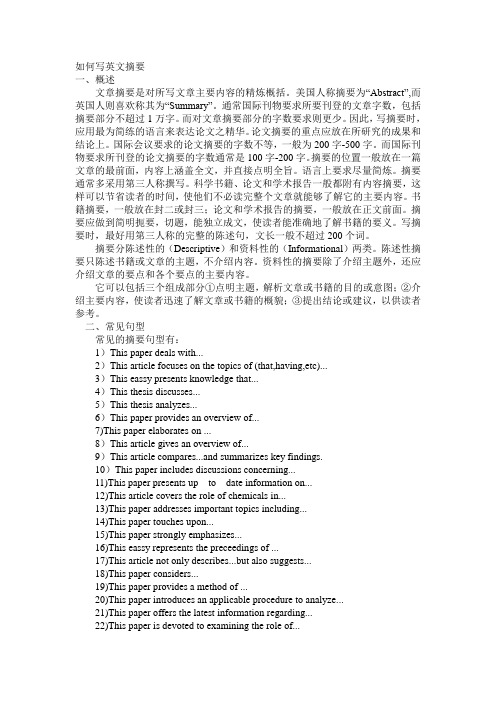
如何写英文摘要一、概述文章摘要是对所写文章主要内容的精炼概括。
美国人称摘要为“Abstract”,而英国人则喜欢称其为“Summary”。
通常国际刊物要求所要刊登的文章字数,包括摘要部分不超过1万字。
而对文章摘要部分的字数要求则更少。
因此,写摘要时,应用最为简练的语言来表达论文之精华。
论文摘要的重点应放在所研究的成果和结论上。
国际会议要求的论文摘要的字数不等,一般为200字-500字。
而国际刊物要求所刊登的论文摘要的字数通常是100字-200字。
摘要的位置一般放在一篇文章的最前面,内容上涵盖全文,并直接点明全旨。
语言上要求尽量简炼。
摘要通常多采用第三人称撰写。
科学书籍、论文和学术报告一般都附有内容摘要,这样可以节省读者的时间,使他们不必读完整个文章就能够了解它的主要内容。
书籍摘要,一般放在封二或封三;论文和学术报告的摘要,一般放在正文前面。
摘要应做到简明扼要,切题,能独立成文,使读者能准确地了解书籍的要义。
写摘要时,最好用第三人称的完整的陈述句,文长一般不超过200个词。
摘要分陈述性的(Descriptive)和资料性的(Informational)两类。
陈述性摘要只陈述书籍或文章的主题,不介绍内容。
资料性的摘要除了介绍主题外,还应介绍文章的要点和各个要点的主要内容。
它可以包括三个组成部分①点明主题,解析文章或书籍的目的或意图;②介绍主要内容,使读者迅速了解文章或书籍的概貌;③提出结论或建议,以供读者参考。
二、常见句型常见的摘要句型有:1)This paper deals with...2)This article focuses on the topics of (that,having,etc)...3)This eassy presents knowledge that...4)This thesis discusses...5)This thesis analyzes...6)This paper provides an overview of...7)This paper elaborates on ...8)This article gives an overview of...9)This article compares...and summarizes key findings.10)This paper includes discussions concerning...12)This article covers the role of chemicals in...13)This paper addresses important topics including...14)This paper touches upon...15)This paper strongly emphasizes...16)This eassy represents the preceedings of ...17)This article not only describes...but also suggests...18)This paper considers...19)This paper provides a method of ...20)This paper introduces an applicable procedure to analyze...21)This paper offers the latest information regarding...22)This paper is devoted to examining the role of...23)This article explores...24)This paper expresses views on...25)This paper reflects the state of the art in...26)This paper explains the procedures for...27)This paper develops the theory of ...28)This article reviews the techniques used in...29)This paper investigates the techniques and procedures to...30)This article is about...31)This eassy is related to ...32)This paper concerns...33)This paper gives an account of ...34)This article tells of...35)This paper tries to describe...36)This paper provides an analysis of ...37)This paper reports the latest information on ...38)The author of this article reviews...39)The writer of this paper discusses...40)The writer of this eassy tries to explore...41)The aim of this paper is to determine...42)The purpose of this article is to review...43)The objective of this paper is to explore...破题用语,一般有:①Th额author of this article reviews (or: discusses,describes,summarizes,examines)something……②This article reviews (or:reports,tells of,is about,concerns)something…….③This article has been prepared (or:designed,written)…….④The purpose of t his article is to determine something…….⑤The problem of something is discussed …….结论和建议,一般有以下几种写法:①The author suggests (recommends,concludes)that…….②This article shows that…….③It is suggested that…….④The author's suggestion (or:conclusion )is that ……⑤The author finds it necessary to …….三、分类举例1)陈述型论文摘要。
英文摘要书写技巧

英文摘要书写技巧【摘要】Abstract:Introduction:This article will provide insights into the key techniques for writing an effective abstract in English academic writing.【关键词】关键词:英文摘要、书写技巧、引言、关键词选择、清晰表达、简洁表达、缩写、句子结构、语法错误、拼写错误、结论、摘要技巧1. 引言1.1 IntroductionIn this article, we will discuss some key techniques for writing an abstract in English. We will cover important aspects such as selecting appropriate keywords, expressing ideas clearly and concisely, using abbreviations judiciously, avoiding long and complex sentence structures, and ensuring proper grammar and spelling. By following these tips, researchers and scholars can improve the quality of their abstracts and increase the chances of their work being noticed and cited by others in their field.2. 正文2.1 关键词的选择Try to use a mix of broad and specific terms to capture the breadth and depth of your research. Avoid using overly technical jargon that may not be familiar to a wider audience. Additionally, make sure to include synonyms and related terms to increase the chances of your abstract showing up in different search queries.2.2 清晰和简洁的表达One way to achieve clarity and conciseness in your abstract is to use simple and direct language. Avoid using overly technical terminology or jargon that may be unfamiliar to your audience. Instead, choose words that are commonly understood and accurately convey your meaning.2.3 适当使用缩写1. Define abbreviations when they are first used: When you introduce an abbreviation in your abstract, be sure to spell out the full term followed by the abbreviation in parentheses. For example, "The World Health Organization (WHO) recommends..."2.4 避免冗长和复杂的句子结构Another tip is to break up long sentences into shorter, more manageable chunks. This can help to improve the flow of the abstract and make it easier for readers to follow along. Additionally, using bullet points or lists can help to organize information in a clear and concise manner.2.5 注意语法和拼写错误When writing an English abstract, it is crucial to pay attention to grammar and spelling errors. These mistakes can greatly impact the overall quality and professionalism of your abstract. Here are some tips to help you avoid these errors:3. 结论3.1 SummaryIn summary, mastering the skills of writing an effective English abstract is crucial for researchers and academics. By carefully selecting appropriate keywords, expressing ideas clearly and concisely, using abbreviations judiciously, avoiding long and complex sentence structures, and paying attention to grammar and spelling errors, authors can ensure that their abstracts are informative, engaging, and easily understood by a wide audience. A well-written abstract can significantly enhance the visibility and impact of a research paper, attracting morereaders and increasing the likelihood of citations. Therefore, it is important for writers to practice and refine their abstract writing skills, with a focus on clarity, precision, and accuracy. By following the tips and guidelines outlined in this article, authors can improve the quality of their abstracts and increase the chances of their research being recognized and appreciated in the academic community.3.2 ConclusionIn conclusion, writing a concise and effective abstract requires careful consideration of key elements such as keyword selection, clarity and brevity of expression, appropriate use of abbreviations, avoidance of lengthy and complex sentence structures, and attention to grammar and spelling errors. By following these tips, researchers can craft abstracts that effectively summarize their work and attract the attention of readers. Ultimately, a well-written abstract can enhance the visibility and impact of a research study, making it more likely to be read and cited by others in the field. Researchers should therefore devote time and effort to honing their abstract writing skills in order to effectively communicate the significance of their work and contribute to the advancement of knowledge in their respective fields.。
英文摘要书写技巧
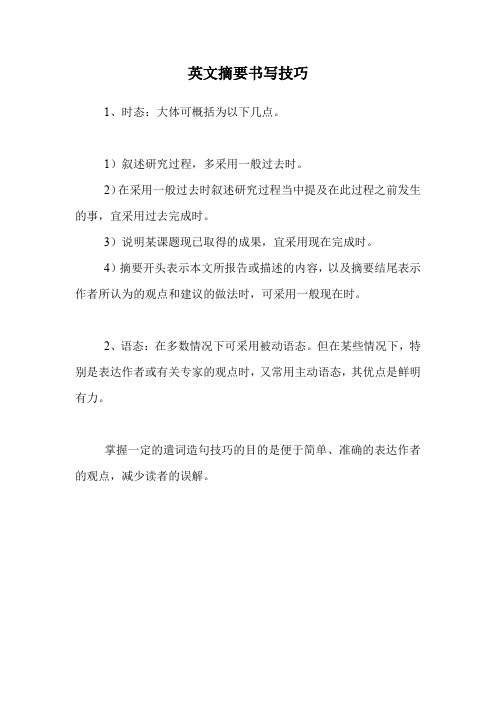
英文摘要书写技巧
1、时态:大体可概括为以下几点。
1)叙述研究过程,多采用一般过去时。
2)在采用一般过去时叙述研究过程当中提及在此过程之前发生的事,宜采用过去完成时。
3)说明某课题现已取得的成果,宜采用现在完成时。
4)摘要开头表示本文所报告或描述的内容,以及摘要结尾表示作者所认为的观点和建议的做法时,可采用一般现在时。
2、语态:在多数情况下可采用被动语态。
但在某些情况下,特别是表达作者或有关专家的观点时,又常用主动语态,其优点是鲜明有力。
掌握一定的遣词造句技巧的目的是便于简单、准确的表达作者的观点,减少读者的误解。
- 1、下载文档前请自行甄别文档内容的完整性,平台不提供额外的编辑、内容补充、找答案等附加服务。
- 2、"仅部分预览"的文档,不可在线预览部分如存在完整性等问题,可反馈申请退款(可完整预览的文档不适用该条件!)。
- 3、如文档侵犯您的权益,请联系客服反馈,我们会尽快为您处理(人工客服工作时间:9:00-18:30)。
英文摘要撰写的一般技巧
由于大多数检索系统只收录论文的摘要部分或其数据库中只有摘要部分免费提供,并且有些读者只阅读摘要而不读全文或常根据摘要来判断是否需要阅读全文,因此摘要的清楚表达十分重要。
为确保摘要的“独立性”(stand on its own)或“自明性”(self-contained),撰写中应遵循以下规则:
(1)为确保简洁而充分地表述论文的IMRD (Introduction, Methods, Results and Discussio n)结构的写作模式,可适当强调研究中的创新、重要之处(但不要使用评价性语言);尽量包括论文中的主要论点和重要细节(重要的论证或数据)。
(2)使用简短的句子,表达要准确、简洁、清楚;注意表述的逻辑性,尽量使用指示性的词语来表达论文的不同部分(层次),如使用“We found that…”表示结果;使用“We suggest t hat…”表示讨论结果的含义等。
(3)应尽量避免引用文献、图表,用词应为潜在的读者所熟悉。
若无法回避使用引文,应在引文出现的位置将引文的书目信息标注在方括号内;如确有需要(如避免多次重复较长的术语)使用非同行熟知的缩写,应在缩写符号第一次出现时给出其全称。
(4)为方便检索系统转录,应尽量避免使用化学结构式、数学表达式、角标和希腊文等特殊符号。
(5)查询拟投稿期刊的读者须知,以了解其对摘要的字数和形式的要求。
如果是结构式摘要,应了解其分为几段,使用何种标识、时态,是否使用缩写或简写,等等。
摘要写作的时态
摘要写作时所采用的时态应因情况而定,力求表达自然、妥当。
写作中可大致遵循以下原则:
(1)介绍背景资料时,如果句子的内容为不受时间影响的普遍事实,应使用现在式;如果句子的内容是对某种研究趋势的概述,则使用现在完成式。
例如:
The authors review risk and protective factors for drug abuse, assess a number of approa ches for drug abuse prevention potential with high-risk groups, and make recommendations for research and practice. [Psychological Bulletin, 1992, 112 (1): 64-105]
Previous research has confirmed four dimensions of temperament:…. [Archives of Gener al Psychiatry, 1993, 50 (12): 975-990]
(2)在叙述研究目的或主要研究活动时,如果采用“论文导向”,多使用现在式(如:This paper presents…); 如果采用“研究导向”,则使用过去式(如:This study investigated…)。
This article summarizes research on self-initiated and professionally facilitated change of addict ive behaviors using the key transtheoretical constructs of stages and processes of change. [Ame rican Psychologist, 1992, 47 (9): 1102-1114]
We investigated whether captopril could reduce morbidity and mortality in patients with l eft ventricular dysfunction after a myocardial infarction.[New England Journal of Medicine, 19 92, 327 (10): 669-677]
(3)概述实验程序、方法和主要结果时,通常用现在式。
We describe a new molecular approach to analyzing the genetic diversity of complex mic robial populations. [Applied and Environmental Microbiology, 1993, 59 (3): 695-700] Our results indicate that p21 may be a universal inhibitor of cyclin kinases. [Nature, 199 3, 366 (6456): 701-704]
(4)叙述结论或建议时,可使用现在式、臆测动词或may, should, could等助动词。
We suggest that climate instability in the early part of the last interglacial may have dela yed the melting of the Saalean ice sheets in America and Eurasia, perhaps accounting for this discrepancy. [Nature, 1993, 364 (6434): 218-220]
摘要写作的人称和语态
有相当数量的作者和审稿人认为,科技论文的撰写应使用第三人称、过去时和被动语态。
但调查表明,科技论文中被动语态的使用在1920-1970年曾经比较流行,但由于主动语态的表达更为准确,且更易阅读,因而目前大多数期刊都提倡使用主动态。
国际知名科技期刊“Nature”, “Cell”等尤其如此,其中第一人称和主动语态的使用十分普遍。
在论文撰写时应认真调查一下拟投稿期刊有关人称和语态的使用习惯,为简洁、清楚地表达研究成果,在论文摘要的撰写中不应刻意回避第一人称和主动语态。
相关论文:任胜利. 科技论文英文摘要的撰写. 中国科技期刊研究, 2004, 15(1): 112-115。
